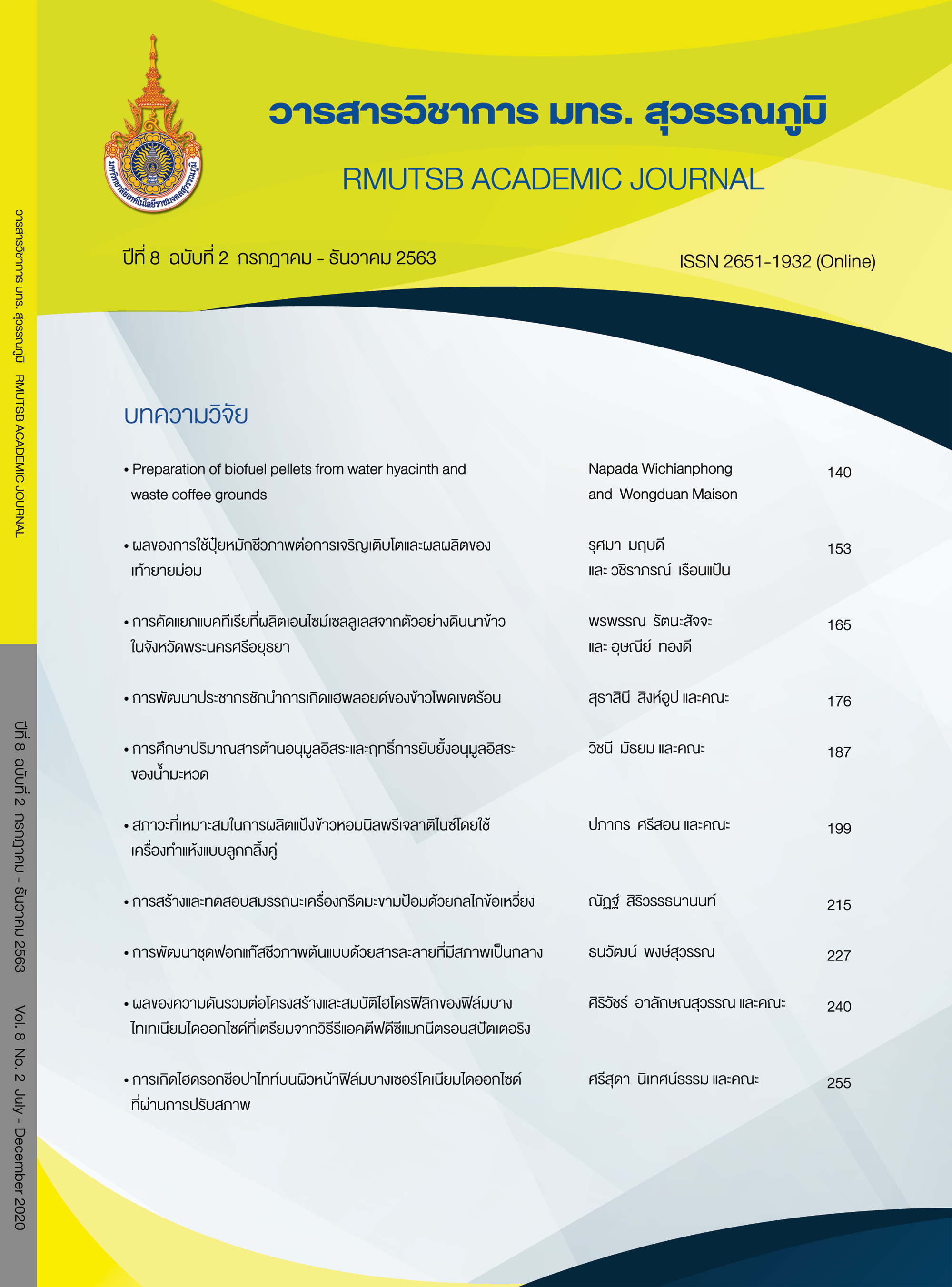Development of biogas scrubber prototype by using neutral solution
Main Article Content
Abstract
One of the most important problems for electrical production from the biogas by using vinasse as a reactant is a hydrogen sulfide gas (H2S). This gas is one of many products from microbial metabolism. It is the corrosive substance that causes damage in metal composite parts of the machine and the human respiratory system. The aim of biogas scrubber development was to reduce the hazard gas before pass through the biogas generator. The principle of the scrubber prototype was designed as a spray tower. The droplet (pH adjusted water) was moved from the top to the bottom by gravity and solution pressure while H2S was injected from the bottom of the prototype scrubber. The counter-current flow was occurred. The results indicated that the elimination efficiency was enhanced by packing material in the scrubber. The high acidity of drained wastewater had run out of scrubber bottom. After that, the waste solution was passed through the pH adjustment system (pH 7.0+0.2) and the solution was returned to the gas scrubber in order to generate the recovery solution. The optimum flow rate of pH adjusted solution was 200 mL/min and the inlet gas flow rate was 50 mL/min. With the prototype scrubber, the concentration of H2S was tested in the range of 15,600+1,300 mg/L. The obtained concentration of hydrogen sulfide was lower than 50%.
Article Details
Published manuscript are the rights of their original owners and RMUTSB Academic Journal. The manuscript content belongs to the authors' idea, it is not the opinion of the journal's committee and not the responsibility of Rajamangala University of Technology Suvarnabhumi
References
Abatzoglou, N., & Boivin, S. (2009). A review of biogas purification processes. Biofuels, Bioproducts and Biorefining, 3(1), 42-71.
Barros, R. M., Tiago, F. G. L., & da Silva, T. R. (2014). The electric energy potential of landfill biogas in Brazil. Energy Policy, 65, 150-164.
Clough, S. A., Beers, Y., Klein, G. P., & Rothman, L. S. (1973). Dipole moment of water from Stark measurements of H2O, HDO, and D2O. The Journal of Chemical Physics, 59(5), 2254-2259.
Chang, R. (2010). Chemistry. Boston: McGraw-Hill.
Choo, H. S., Lau, L. C., Mohamed, A. R., & Lee, K. T. (2013). Hydrogen sulfide adsorption by alkaline impregnated coconut shell activated carbon. J. Eng. Sci. Technol, 8(6), 741-753.
Duan, H., Koe, L. C. C., & Yan, R. (2005). Treatment of H2S using a horizontal biotrickling filter based on biological activated carbon: reactor setup and performance evaluation. Applied microbiology and biotechnology, 67(1), 143-149.
Gantina, T. M., Iriani, P., & Wachjoe, C. K. (2020). Biogas purification using water scrubber with variations of water flow rate and biogas pressure. Journal of Physics: Conference Series, 1450, 012011.
Jang, N., Yasin, M., Park, S., Lovitt, R. W., & Chang, I. S. (2017). Determination of volumetric gas–liquid mass transfer coefficient of carbon monoxide in a batch cultivation system using kinetic simulations. Bioresource technology, 239, 387-393.
Morton, C. M. (2008). The effect of pH on hydrogen sulfide and carbon dioxide absorption in packed towers. Proceedings of the Water Environment Federation, 2008(4), 671-683.
Moustiri, S., Hebrard, G., & Roustan, M. (2002). Effect of a new high porosity packing on hydrodynamics of bubble columns. Chemical Engineering and Processing: Process Intensification, 41(5), 419-426.
Noorain, R., Kindaichi, T., Ozaki, N., Aoi, Y., & Ohashi, A. (2019). Biogas purification performance of new water scrubber packed with sponge carriers. Journal of cleaner production, 214, 103-111.
Onthong, U., & Juntarachat, N. (2017). Evaluation of biogas production potential from raw and processed agricultural wastes. Energy Procedia, 138, 205-210.
Parsaee, M., Kiani, M. K. D., & Karimi, K. (2019). A review of biogas production from sugarcane vinasse. Biomass and bioenergy, 122, 117-125.
Robles-Gonzalez, V., Lopez-Lopez, E., Martinez-Jeronimo, F., Ortega-Clemente, A., Ruiz-Ordaz, N., Galindez-Mayer, J., & Poggi-Varaldo, H. M. (2010). Combined treatment of mezcal vinasses by ozonation and aerobic biological post-treatment. In Procedings of 14th International Biotechnology Symposium (Vol. 1418). Rimini, Italy: University of Bologna.
Ramírez, M., Gómez, J. M., Aroca, G., & Cantero, D. (2009). Removal of hydrogen sulfide by immobilized Thiobacillus thioparus in a biotrickling filter packed with polyurethane foam. Bioresource Technology, 100(21), 4989-4995.
Roberts, B. E., & Mather, A. E. (1988). Solubility of CO2 and H2S in a mixed solvent. Chemical Engineering Communications, 72(1), 201-211.
Rotunno, P., Lanzini, A., & Leone, P. (2017). Energy and economic analysis of a water scrubbing based biogas upgrading process for biomethane injection into the gas grid or use as transportation fuel. Renewable energy, 102, 417-432.
Sangave, P. C., & Pandit, A. B. (2006). Enhancement in biodegradability of distillery wastewater using enzymatic pretreatment. Journal of Environmental Management, 78(1), 77-85.
Suphanburi Provincial Industry Office. (2019). List of Industrials in Suphanburi province data is presented as of 31 August 2019. Retrieved January 3, 2020, from http://www.industry.go.th/suphanburi/index.php/activityreport/302-31-59-1?path= (in Thai)
Urban, W., Lohmann, H., & Gómez, J. S. (2009). Catalytically upgraded landfill gas as a cost-effective alternative for fuel cells. Journal of Power Sources, 193(1), 359-366.
Viswanathan, R., & Dyke, T. R. (1984). Electric dipole moments and nuclear hyperfine interactions for H2S, HDS, and D2S. Journal of Molecular Spectroscopy, 103(2), 231-239.
Weinlaender, C., Neubauer, R., Hauth, M., & Hochenauer, C. (2017). Removing H2S from biogas using sorbents for solid oxide fuel cell applications. Chemie Ingenieur Technik, 89(9), 1247-1254.
Wellinger, A., & Lindberg, A. (2005). Biogas upgrading and utilization. IEA Bioenergy Task 24: energy from biological conversion of organic waste. London: IEA Bioenergy.
Wicaksono, A. M., Hermana, J., & Slamet, A. (2018). Reducing CO2 and H2S Gas in Biogas Using Wet Scrubber Method with Ca(OH)2 Solution. In 11th International conference on advances in agricultural, biological, civil and environmental science (pp. 67-71). Bali, Indonesia: Dignified Researchers in Agricultural, Biological and Life Sciences.
Zhenqi, N., Yincheng, G., & Wenyi, L. (2009). Experimental studies on CO2 Capture in a spray scrubber using NaOH solution. In 2009 International Conference on Energy and Environment Technology (pp. 52–55), Guilin, Guangxi, China: IEEE.


